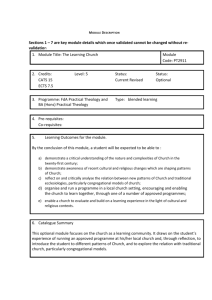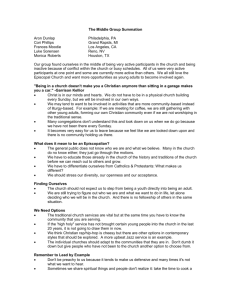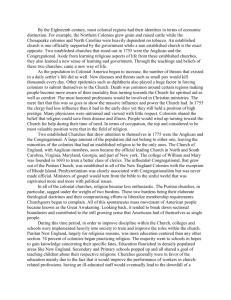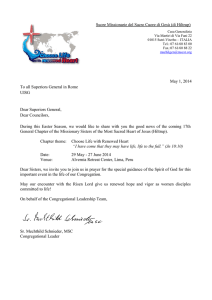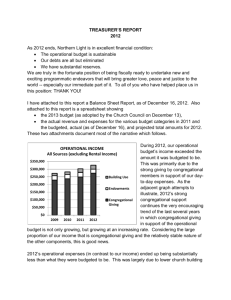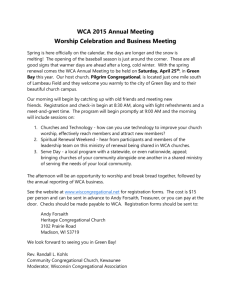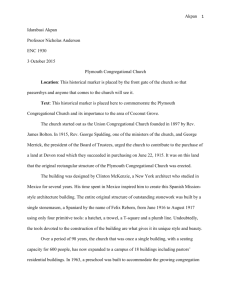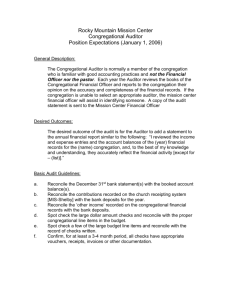congregationalism and pacifism
advertisement
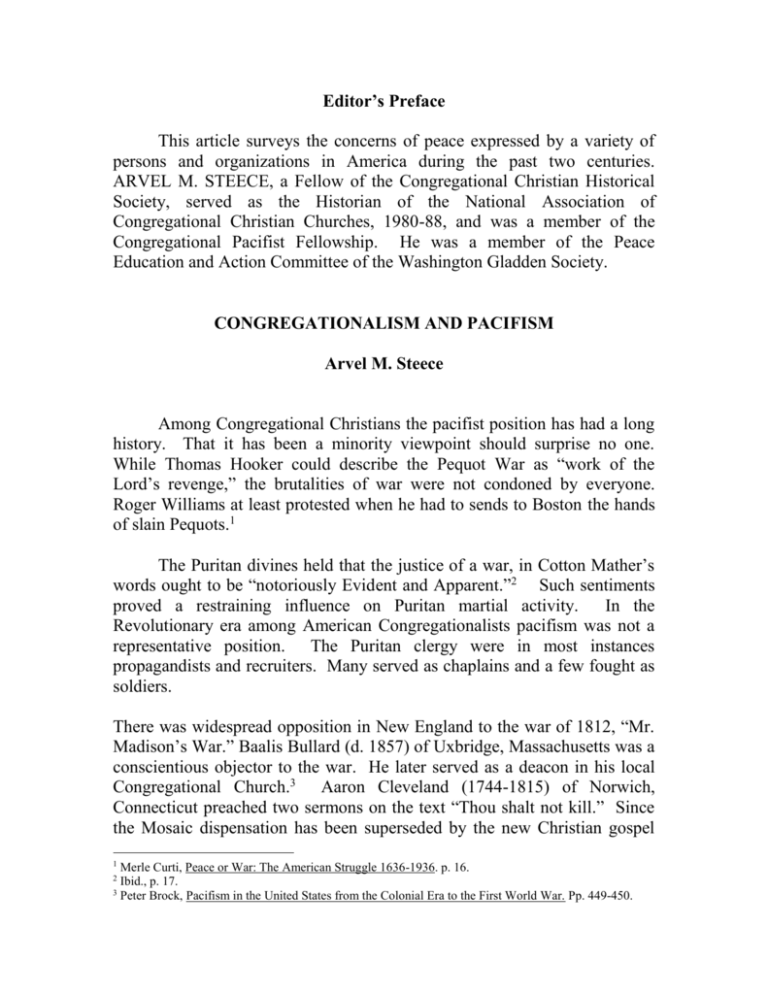
Editor’s Preface This article surveys the concerns of peace expressed by a variety of persons and organizations in America during the past two centuries. ARVEL M. STEECE, a Fellow of the Congregational Christian Historical Society, served as the Historian of the National Association of Congregational Christian Churches, 1980-88, and was a member of the Congregational Pacifist Fellowship. He was a member of the Peace Education and Action Committee of the Washington Gladden Society. CONGREGATIONALISM AND PACIFISM Arvel M. Steece Among Congregational Christians the pacifist position has had a long history. That it has been a minority viewpoint should surprise no one. While Thomas Hooker could describe the Pequot War as “work of the Lord’s revenge,” the brutalities of war were not condoned by everyone. Roger Williams at least protested when he had to sends to Boston the hands of slain Pequots.1 The Puritan divines held that the justice of a war, in Cotton Mather’s words ought to be “notoriously Evident and Apparent.”2 Such sentiments proved a restraining influence on Puritan martial activity. In the Revolutionary era among American Congregationalists pacifism was not a representative position. The Puritan clergy were in most instances propagandists and recruiters. Many served as chaplains and a few fought as soldiers. There was widespread opposition in New England to the war of 1812, “Mr. Madison’s War.” Baalis Bullard (d. 1857) of Uxbridge, Massachusetts was a conscientious objector to the war. He later served as a deacon in his local Congregational Church.3 Aaron Cleveland (1744-1815) of Norwich, Connecticut preached two sermons on the text “Thou shalt not kill.” Since the Mosaic dispensation has been superseded by the new Christian gospel 1 Merle Curti, Peace or War: The American Struggle 1636-1936. p. 16. Ibid., p. 17. 3 Peter Brock, Pacifism in the United States from the Colonial Era to the First World War. Pp. 449-450. 2 2 the sixth commandment admits no exceptions. The Life of Man Inviolable By the Laws of Christ was an unusual and daring publication in 1815.4 Cleveland was influence by his son-in-law, David Low Dodge (1774-1852), prosperous New York merchant and Presbyterian elder, who had published anonymously a small tract, The Mediator’s Kingdom not of this World by Spiritual, Heavenly and Divine, (1809). At the conclusion of the war, Dodge published War Inconsistent with the Religion of Jesus, (1815).5 David Osgood (1747-1822), pastor of the Congregational Church of Meford, Massachusetts, indicted the war: “As a teacher of righteousness, as a minister jof Christ I feel myself under obligation infinitely superior to all human laws, most solemnly to testify, both in public and in private, everywhere, in the hearing of all persons, rulers, and subjects, against this atrocious wickedness, and to lay down my life rather than cease this testimony. To you, my brethren, and to all my fellow citizens I say, in the language of the test, “FIGHT YE NOT AGAIANST THE LORD GOD OF YOUR FATHERS: FOR YE SHALL NOT PROSPER.”6 Noah Worcester (1758-1837), a liberal Congregational minister, wrote his classic in the history of the peace literature, A Solemn review of the Custom of War in 1814. No publisher was willing to take such a book while the country was still at war. Despite his poverty, Worcester determined to take half the risk for its printing. Surprisingly the book went through five editions in fifteen months and by 1846 had been reprinted a dozen times in the United States. Worcester suggested the formation of peace societies and a confederacy of nations with an international court for settling national disputes. Acting on his own suggestions, he founded the Massachusetts Peace Society, December 28, 1815. From 1815 to 1828, he published a quarterly journal, the Friend of Peace. Worcester’s pen and purse largely supported this first periodical in the world devoted exclusively to peace. William Ladd (1778-1841), sea captain and farmer, founded the American Peace Society in New York, May 8, 1828 and henceforth devoted his life to it and the cause of peace. Ladd’s Essay on the Congress of Nations (1840) presented a plan which was realized in the Hague Conference of 1899 and the resulting tribunal. In 1837, the same year he became a Congregational minister, Ladd enunciated his stand against defensive as well as offensive war. 4 Ibid., p. 461-464. Ibid., p. 451-453. 6 David Osgood, “The Mexican War: A Sermon,” p. 1, 24. 5 2 3 Henry Clark Wright (1797-1870), originally a hat maker from Connecticut, was ordained to the Congregational ministry, worked for the American Sunday School Union and the American Peace Society, and was an early convert to absolute pacifism. In 1832 rev. Cyrus Yale (1786-1854) addressed the Hartford County Peace Society and when the address was published as War Unreasonable and Unscriptural he presented additional material calling upon the United States to become the first country to adopt “the principle of the entire abstinence from war.”7 In 1833, Laurens P. Hickok (1798-1888), Pastor at Litchfield, spoke to the Connecticut Peace Society in a more conservative vein on The Sources of Military Delusion. Dr. William Allen (1784-1868), president of Bowdoin College, and a vice-president of the American Peace Society wrote “Defensive War Vindicated.” The article was published in Calumet in 1834 and represented a moderate pacifist position. Thomas C. Upham (1799-1872), a Congregational minister who was a professor at Bowdoin College, produced The Manual of Peace, (New York, 1836), a kind of peace encyclopedia. While it contributes nothing new to the theology of Christian pacifism, it does represent a landmark in the history of the peace movement in its concern for personal resistance to war and its presentation of active conscientious objection.8 George Cone Beckwith (1801-1870) who had been a professor at Lane Theological Seminary and pastor of Congregational Churches in Portland, Maine, and Lowell, Massachusetts became, at Ladd’s request, secretary of the Society and editor of its periodical in 1837. James Browning Miles (1822-1875) left the pastorate of the Congregational Church in Charlestown, Massachusetts to become Beckwith’s successor in 1871. 7 8 Brock, Op. Cit. p. 499. Ibid. 3 4 The Mexican War was not popular in New England. The anti-slavery people saw it as an attempt of the pro-slavery elements to expand the territory from which new slave states might be created. Samuel Harris (1814-1899) in a sermon delivered on the annual Thanksgiving at Conway, Massachusetts in 1846 on the text, “Woe to him that buildeth a town with blood and establisheth a city by iniquity,” (Habakkuk 2:12) saw his pastoral responsibility, “rising above the bias of party or sect, above partiality or fear, or any selfish consideration, to plead for humanity against all wrongs, to proclaim the truth in its sever and simple majesty, and to vindicate all God’s claims on men…” After discussing the issues behind the war, he concluded: “…and, so far as you believe I have spoken the truth, you will offer your prayers, and put forth your influence, not only that this war may cease, but that the evil sentiments and institutions which have occasioned and which perpetuate it, and which are strengthened and extended by it may be done away.”9 In a discourse delivered on the Annual Fast of 1847 Burdett Hart (1821-1906), pastor of the Congregational Church in Fair Haven, Connecticut, observed: “For the acquisition of slave-territory we are now engaged in a wicked war, whose issues are in the unknown future. The period for forbearance and truckling slavishness has passed. We are to remember our birthright. We owe a debt of justice to ourselves. We owe a debt of obedience to God. This war – I hesitate not to say it – is in resistance to His commands. We are forgetful who is on the throne. It is a Being who is fearfully just. He watches the nations – and the whole history of the past assures us that He metes out to them a terrible recompense for their crimes. The blasted ruins of States illustrious in the records of former ages, stand as stern monuments along the track of time, mournfully and faithfully reminding us of our duty or our doom. Let us heed in season the voice that comes up from the sepulchers of departed greatness…”10 Elihu Burritt (1810-1879), the “learned Blacksmith” and one of the best known figures in the nineteenth century peace movement, was nominally affiliated to New England Congregationalism. He founded in 1846 the League of Universal Brotherhood with this pledge: “Believing war to be inconsistent with the spirit of Christianity, and destructive to the best interests of mankind, I do hereby pledge myself never to enlist or enter into any army or navy, or to yield any voluntary support or sanction to the preparation for or prosecution of any war, by whomsoever, for whatsoever proposed, declared, or waged. 9 Samuel Harris, “The Mexican War: A Sermon,” p. 1, 24. Burdett Hart, “The Mexican War: A Discourse,” p. 15. 10 4 5 And I do hereby associate myself with all persons, of whatever country, conditions, or colour, who have signed, or shall hereafter sign this pledge, in a League of Universal Brotherhood; whose object shall be, to employ all legitimate and moral means for the abolition of all war, and all spirit, and all the manifestations of war, throughout the world; for the abolitions of all restrictions upon international correspondence and friendly intercourse, and of whatever else tends to make enemies of nations, or prevents their fusion into one peaceful brotherhood; for the abolition of all institutions and customs which do not recognize the image of God and a human brother in every man of whatever clime, colour, or condition of humanity.”11 During its eleven year history, the League accomplished much in the way of increasing international understanding. Peace congresses were held in Brussels (1848), Paris (1849), Frankfort-a-Main (1850), and London (1851). Its periodical was the Bond of Brotherhood. The League ended its formal existence by fusing with the old London Peace Society in Britain and with the American Peace Society in the United States. The major peace movement of the mid-nineteenth century never really took an absolutist position and during the Civil War the fight to free the slave absorbed the energy of the reformers. The great evangelist, Dwight L. Moody (1837-1899) refused on grounds of conscience to participate in the Civil War as a soldier. He explained that there never was a time in his life when he felt he could take a gun and shoot a fellow-being. His objection to bearing arms did not prevent him from engaging in evangelistic and welfare work among the Union soldiers and he became active in the “Christian commission,” a private organization approved by the military leaders and dedicated to the spiritual welfare of the troops. During the 1880’s and 1890’s the National Council of Congregational Churches passed resolutions commending the American Peace Society and encouraging works to improve international relations. Washington Gladden (1836-1918) and Josiah Strong (1847-1916) were active in these efforts. Despite the popular view that the Spanish American War was part of America’s Manifest Destiny there was still a belief that the new century would usher in an era of peace and that war would be outlawed. Horace Everett Warner (1839-1930), a Congregationalist, published The Ethics of Force (1905). The book was originally a series of lectures 11 Merle Curti, The American Peace Crusade 1815-1860, p. 145. 5 6 before the Ethical Club in Washington. Warner was squarely in favor of Christian pacifism and held that if humanity was to survive in the twentieth century, warfare had to be abolished. Charles E. Beals (1869-1931) had entered the Congregational ministry in 1896 and served pastorates in Massachusetts prior to serving as a field secretary for the American Peace Society 1908-12, director of central west department, 1912-14, secretary of the Chicago Peace Society, 1910-14. During his tenure, he traveled 150,000 miles, raised more than $50,000 and welcomed a thousand new members. Charles Frederic Aked (1864-1941) was an English Baptist who founded the Passive Resistance League in his native country. Coming to America, he entered the Congregational ministry in 1911 and served churches in San Francisco and Kansas City, Missouri. He was a member of Henry Ford’s Peace Ship Expedition in 1915. That same year he addressed the National Council of Congregational Churches on the subject, “An International Conscience” and observed: “…You yourselves at times mildly reprove the individual whom you call an ultrapacifist; you blandly remark upon the impracticability of what you designate as peace-atany-price doctrines; you pray for Peace and you prepare for War. In a word: There is war in the world today because you, and men and women like you, and men and women not so wise and good as you, believe that war has to be. And war will cease throughout the world when you, and men and women like you and men and women not so wise and good as you, believe that war need not be. We have to change the atmosphere…”12 The Congregational Churches sought to encourage peace. When the nation entered World War I, the conflict was seen as a great crusade to end war. Few of the ministers who had promoted peace continued openly to voice their sentiments. A.J. Muste (1885-1967) had been installed as a minister of the Central Congregational Church, Newtonville, Massachusetts in 1915 but because of his pacifism he was encouraged to take a leave of absence from his pulpit. Dr. Sydney D. Strong (1860-1938) was reprimanded for his pacifist beliefs by other clergy. Jane Addams (1860-1935) was an outspoken pacifist and one of the founders of the Women’s International League for Peace and Freedom organized in Zurich in 1919 as an outgrowth of the International Congress of Women which had met at the Hague in 1915. 12 Charles F. Aked, “An International Conscience: An Address,” p. 10. 6 7 The American Peace Society, always a conservative organization, “bowed to the inevitable” and accepted World War I. The F.O.R. (Fellowship of Reconciliation) was begun in 1915 and became the major organization of religious pacifists during the first half of the twentieth century. It represented a major restructuring of the peace movement to include a more progressive element drawing its members from Quakers, YMCA leaders and social gospel clergy. Frederick J. Libby (1874-1970) was ordained a Congregational minister in 1905 and served a church in Massachusetts. From 1912 to 1920 he was on the faculty of Phillips Academy, Exeter, New Hampshire. He had studied in Europe and traveled abroad. In 1917 he was rejected by the YMCA when he applied for work with prisoners of war because he was a member of the pacifist Fellowship of Reconciliation. Accepted by the American Friends Service Committee, his experience in Europe convinced him to work full time for peace. He became a member of the Society of Friends. He was a leader in the National Council for the Limitations of Armaments which changed its name in 1922 to the National Council for Prevention of War. In the 1920’s and 1930’s, there was a resurgence of peace sentiment among the churches. The Church Peace Union, which had been founded in 1914 with financial aid from Andrew Carnegie, continued active. It was not a pacifist organization. It later changed its name to the Council on Religion and International Affairs. In the first sixty years of its life, three Congregational ministers, Frederick Henry Lynch (1867-1934), Henry Avery Atkinson (1877-1960) and A. William Loos (1908), provided much of the leadership. Lynch wrote Mobilizing for Peace (1937). In the years between World War I and World War II, the National Council of Congregational Churches and its successor the General Council of Congregational Christian Churches passed a variety of peace resolutions. In 1938 the right of conscientious objectors to register was recognized: “BE IT RESOLVED: That the General Council of Congregational Christian Churches make representations to the United States Government asking that those members of the said Congregational and Christian 7 8 churches who wish to do so may be permitted to register as conscientious objectors to participation in any of the activities of war and that their objections be recognized as valid by the United States Government.” In 1940 there was a resolution regarding the registering of conscientious objectors and in 1944 there was action concerning fair treatment for conscientious objectors. In 1950 the validity of conscientious objection was reaffirmed and similar action was taken in 1954 and 1958. The text of the 1950 statement is presented here: RESOLUTION ON CONSCIENTIOUS OBJECTORS General Council of the Congregational Christian Churches Of the U.S.A. June 1950 Whereas the Selective Service Act provides for the registration and military service of American youth, And whereas there are young men in our churches who for conscience sake seek the exemption provided in law or feel under the spiritual necessity of disobeying the law, And whereas the historic position of the Congregational Christian Churches, stated on frequent occasions by the General Council, recognizes the right of conscientious objection to participate in or support of war and preparation for war, and accepts the Conscientious Objector’s position as a valid expression of the Christian faith as do the “historic peace churches,” And whereas the General Council has expressed our common desire to hold within our fellowship all who obey conscience, whatever their choice of action with respect to war, And whereas in times past the General Council has organized a committee to be of assistance to any Conscientious Objectors who may need a service of counsel and practical help, BE IT RESOLVED: That we re-affirm our position regarding Conscientious Objectors and that through the new Committee on Conscientious Objectors established by the Executive Committee of the General Council, offer such assistance as may be possible, and urge all 8 9 ministers and laymen to hold closely within the fellowship of the Churches those who take this position. The Congregational Christian Pacifist Fellowship was organized at Grinnell, Iowa in 1946 and adopted this covenant at that time: “In loyalty to the teachings of Jesus Christ and in obedience to the will of God as I understand it, I am committed in conscience to redemptive love as the way of life. In expression of this conviction I cannot participate in war or give it my support. I accept it as my task to work for peace, for justice, and for the reconciliation of mankind.”13 The organization had no staff. Every two years its members who attended the General Council gathered to discuss mutual concerns and elect officers. At Oberlin, Ohio in 1948, Philip Sarles and William Clark were chosen co-chairmen. The 1950 meeting at Cleveland, Ohio named Albert Buckner Coe chairman. In 1952 at Claremont, California, the group chose Alan Jenkins to the chairmanship. The organization cooperated with the Fellowship of Reconciliation and Jenkins reported that seven Congregationalists and five Evangelical and Reformed had met in denominational sessions during the Fellowship of Reconciliation National Conference. He also attended the Detroit Conference, “The Churches and Peace” in 1953. No meeting of the Congregational Christian Peace Fellowship was held at the New Haven General Council in 1954. At Omaha in 1956, Charles Brewster was selected chairman. In 1958 the name was changed to the Congregational Christian Fellowship for Peace. No officers were elected that year in anticipation of an eventual merger with the Evangelical and Reformed Peace Fellowship. The United Church Peace Fellowship was established July 4, 1959 and a new statement of purpose was adopted in 1961. Across the years, the peace witness has continued in the United Church of Christ where there is now (1983) a Peace Advocate in the Washington Office of Church and Society. While the United Church Peace Fellowship has melded into other peace groups like Clergy and Laity Concerned, some UCC people active in the peace cause have reminded this writer that they feel encouraged by their efforts to turn the attentions of the UCC to the over-riding danger of nuclear war. Peace has been a priority in the UCC program. 13 Congregational Pacifist Fellowship leaflet, n.d. 9 10 In 1968, the Commission on the Ministry of the National Association of Congregational Christian Churches re-affirmed the historic position of the Congregational Churches in regard to freedom of conscience. STATEMENT OF CONSCIENTIOUS OBJECTION We affirm that the following is a veridical statement of the historic position of the Congregational Christian Churches in regard to the matter of conscientious objection: WHEREAS the Selective Service Act provides for the registration and military service of American youth, and WHEREAS there are young men in our Churches who, for the sake of conscience, either seek the exemption provided in the law or are unable to comply with its provisions, and WHEREAS the historic position of the Congregational Christian Churches, stated on frequent occasions in the past, recognizes the right of conscientious objection to participation in war and accepts the conscientious objector’s position as a valid expression of the Christian faith as do the “historic peace churches,” and WHEREAS the fellowship of Congregational Christian Churches has expressed our common desire to hold within our fellowship in love all those whose consciences are bound to Christ – those who accept the call to military service as well as those who cannot participate in war, BE IT RESOLVED that we affirm our position regarding conscientious objectors and urge all ministers and laymen to hold closely within the fellowship of our churches all those who find themselves in this position. The Commission on the Ministry Wichita, Kansas February 12, 1968 10 11 In the 1980’s there has been some informal discussion among people from the member churches of the National Association to revive a pacifist fellowship. A handful of people gathered at Pittsburgh, Pennsylvania in 1982 and found great diversity of viewpoint. This paper is indebted to the works of Brock, Chatfield and Curti. The sermons of Harris, Hart and Osgood are found in the collections of the Congregational Library, Boston. Other examples could be found in those collections. BIBLIOGRAPHY Aked, Charles F. “An International Conscience.” An address delivered to the National Council of Congregational Churches at New Haven, Conn. October 22, 1915. Brock, Peter. Pacifism in the United States from the Colonial Era to the First World War, Princeton University Press, Princeton, New Jersey, 1968. Chatfield, Charles. For Peace and Justice: Pacifism in America 1914-41, University of Tennessee Press, Knoxville, 1971. Curti, Merle Eugene. The American Peace Crusade 1815-1860, Duke University Press, 1929. Reprinted by Octagon Books, New York, 1965. Curti, Charles Eugene. Peace or War: The American Struggle 1636-1936, W.W. Norton and Company, New York, 1936. Harris, Samuel. “The Mexican War.” A Sermon delivered on the annual Thanksgiving at Conway, Massachusetts, November 26, 1846, Greenfield, Merriam and Mirick, 1847. Hart, Burdett. “The Mexican War.” A Discourse delivered at the Congregational Church in Fair Haven on the annual Fast of 1847, New Haven: Peck and Stafford, 1847. Osgood, David. “A Solemn Protest Against the Late Declaration of War in a Discourse Delivered on the Next Lord’s Day After the Tidings of it Were Received.” Cambridge: Hilliard and Metcalf, 1812. 11 12 12
